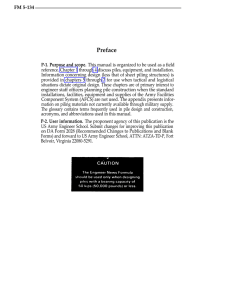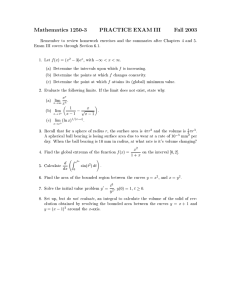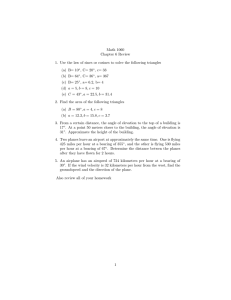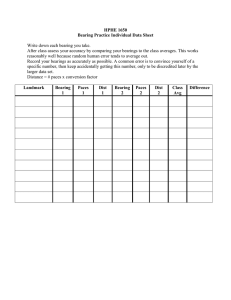SPUK Plant Loading Data Sheet Working Platform Guidance Notes
advertisement
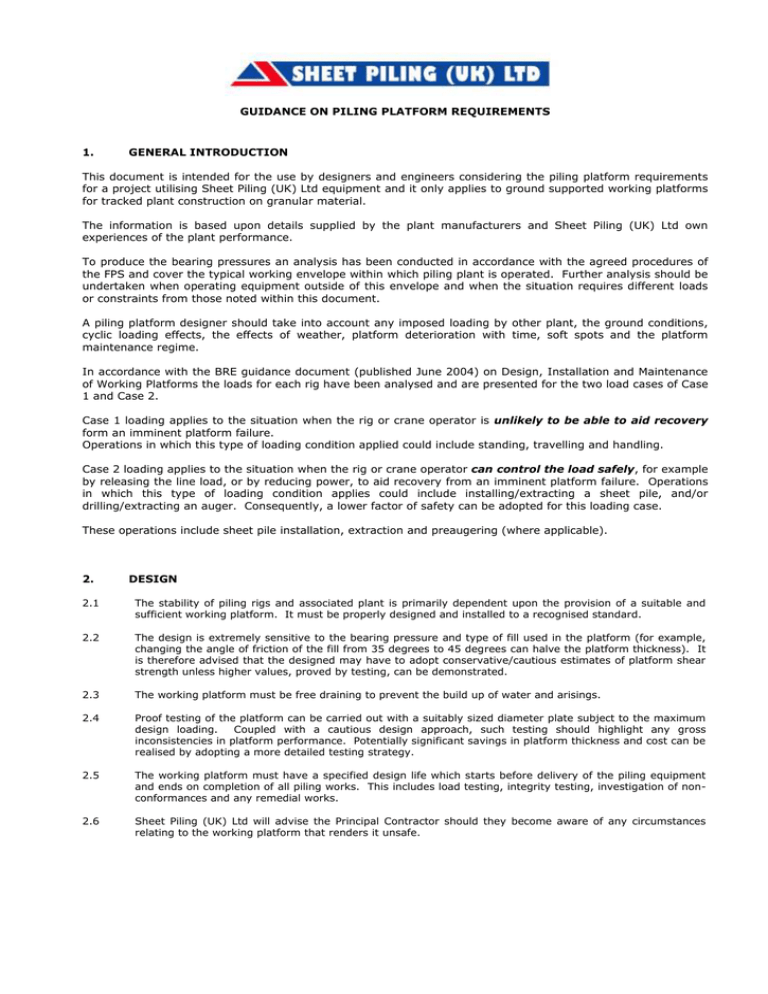
GUIDANCE ON PILING PLATFORM REQUIREMENTS 1. GENERAL INTRODUCTION This document is intended for the use by designers and engineers considering the piling platform requirements for a project utilising Sheet Piling (UK) Ltd equipment and it only applies to ground supported working platforms for tracked plant construction on granular material. The information is based upon details supplied by the plant manufacturers and Sheet Piling (UK) Ltd own experiences of the plant performance. To produce the bearing pressures an analysis has been conducted in accordance with the agreed procedures of the FPS and cover the typical working envelope within which piling plant is operated. Further analysis should be undertaken when operating equipment outside of this envelope and when the situation requires different loads or constraints from those noted within this document. A piling platform designer should take into account any imposed loading by other plant, the ground conditions, cyclic loading effects, the effects of weather, platform deterioration with time, soft spots and the platform maintenance regime. In accordance with the BRE guidance document (published June 2004) on Design, Installation and Maintenance of Working Platforms the loads for each rig have been analysed and are presented for the two load cases of Case 1 and Case 2. Case 1 loading applies to the situation when the rig or crane operator is unlikely to be able to aid recovery form an imminent platform failure. Operations in which this type of loading condition applied could include standing, travelling and handling. Case 2 loading applies to the situation when the rig or crane operator can control the load safely, for example by releasing the line load, or by reducing power, to aid recovery from an imminent platform failure. Operations in which this type of loading condition applies could include installing/extracting a sheet pile, and/or drilling/extracting an auger. Consequently, a lower factor of safety can be adopted for this loading case. These operations include sheet pile installation, extraction and preaugering (where applicable). 2. DESIGN 2.1 The stability of piling rigs and associated plant is primarily dependent upon the provision of a suitable and sufficient working platform. It must be properly designed and installed to a recognised standard. 2.2 The design is extremely sensitive to the bearing pressure and type of fill used in the platform (for example, changing the angle of friction of the fill from 35 degrees to 45 degrees can halve the platform thickness). It is therefore advised that the designed may have to adopt conservative/cautious estimates of platform shear strength unless higher values, proved by testing, can be demonstrated. 2.3 The working platform must be free draining to prevent the build up of water and arisings. 2.4 Proof testing of the platform can be carried out with a suitably sized diameter plate subject to the maximum design loading. Coupled with a cautious design approach, such testing should highlight any gross inconsistencies in platform performance. Potentially significant savings in platform thickness and cost can be realised by adopting a more detailed testing strategy. 2.5 The working platform must have a specified design life which starts before delivery of the piling equipment and ends on completion of all piling works. This includes load testing, integrity testing, investigation of nonconformances and any remedial works. 2.6 Sheet Piling (UK) Ltd will advise the Principal Contractor should they become aware of any circumstances relating to the working platform that renders it unsafe. 3. INSTALLATION 3.1 The Sheet Piling (UK) Ltd Platform Certificate is mandatory for all sites where a piling rig or attendant plant operates. It must be signed by an authorised representative of the Principal Contractor. This merely confirms that the legal duties required under CDM have been carried out. 3.2 The working platform provides access for all piling plant, ancillary plant, deliveries, subcontractors and personnel associated with the piling operations. Properly designed and installed, the working platform could also provide suitable and safe access for following trades for the whole project. 3.3 One of the main causes of rig instability is a result of poor definition of the edge of the working platform. In general the working platform should extend at least 2.0 metres beyond the pile position/edge of the building. This ensures sufficient safe working area for the piling personnel and attendance plant. 3.4 Where access ramps are used to move between working levels these must be of sufficient gradient and width to allow the piling plant to move safely with the stability constraints of the machine. Ramps must be in a straight line between working areas. Piling rigs and cranes cannot change direction on ramps. Where a change in direction is required, this must be on a flat level platform. 4. MAINTENANCE, REPAIR AND REINSTATEMENT 4.1 The working platform must be kept free draining. Water and arisings which are allowed to build up on the working platform can hide recently constructed piles, trip hazards, unstable ground and excavations. 4.2 Obstructions encountered during the piling process will generally required excavation to remove them. This can create a ‘soft spot’ which can result in the rig overturning. It is essential that any excavations made in the working platform are reinstated to the designed standard, including any reinforcement and separation filter/membrane. 4.3 Inspection of the platform should be an ongoing process throughout the design life of the platform. damaged areas must be reinstated to the designed standard. Any Case 2 Loading Extraction (3) Bearing Pressure (kN/m2) Case 2 Loading Installation (2) Bearing Pressure (kN/m2) Case 1 Loading Handling(1) Bearing Pressure (kN/m2) Bearing Pressure (kN/m2) Case 1 Loading Travelling Bauer RTG16 0.70 4.15 51 10 173 2.58 219 2.22 299 1.56 284 1.21 305 1.55 Bauer RTG18 0.70 4.41 65 12 210 2.72 255 2.40 320 1.82 360 1.01 408 1.52 Project Name: Project Number: NOTES Bearing Length (m) 1.92 Equivalent Track 296 Max Rectangular 1.31 Bearing Length (m) 260 Equivalent Track 1.60 Max Rectangular 384 Bearing Length (m) 2.22 Equivalent Track 234 Max Rectangular 2.53 Bearing Length (m) 189 Equivalent Track 6 Max Rectangular 45 Bearing Length (m) 3.82 Equivalent Track 0.60 Max Rectangular Mobilram ABI TM12/15 Plant Manufacturer & Model Working Weight (Te) Track Bearing length (m) Bearing Pressure (kN/m2) Case 1 Loading Standing Tracked Pad Width (m) Max Extraction Force (Te) (2) PILING RIG BEARING PRESSURES Sheet Piling Rigs KEY 1. Handling loads relate to use of auxiliary winch at maximum load and radius. 2. Includes a minimum factor of safety of 1.50 on static loads to account for dynamic forces induced during pile installation. 3. Extraction loads based on a maximum extraction force noted in attached table. Full machine extraction force only possible with reduced reach. Maximum Pile Weight = 1.5Te Maximum Winch Load = 50kN @ 5.70m radius Extraction force applicable to both sheet pile extraction and preaugering MRZV 600 Vibratory Hammer = 3.0Te Maximum reach considered in all load cases. Maximum Pile Weight = 2.5Te Maximum Winch Load = 50kN @ 5.70m radius Extraction force applicable to sheet pile extraction only (not preaugering which machine cannot carry out). MR100V Vibratory Hammer = 4.5Te Maximum reach considered in all load cases. Maximum Pile Weight = 2.5Te Maximum Winch Load = 50kN @ 5.90m radius Extraction force applicable to sheet pile extraction only (not preaugering which machine cannot carry out). MR100V Vibratory Hammer = 4.5Te Maximum reach considered in all load cases. CRAWLER CRANE BEARING PRESSURES Travelling Bearing Pressure (kN/m2) Case 1 Loading Standing Bearing Pressure (kN/m2) Max Extraction Force (Te) (2) Case 1 Loading 2.66 217 2.10 IHI CCH 300 0.76 4.2 41 30 167 2.14 261 1.91 IHI CCH 350 0.76 4.2 35 35 122 2.66 217 2.10 IHI CCH 500 0.76 4.7 58 50 103 4.18 253 2.42 IHI CCH 500 0.76 4.7 51 50 120 3.90 215 2.68 NCK Nova 50 0.85 5.0 68 65 124 4.70 235 2.10 IHI CCH 700 0.76 5.1 63 70 137 3.04 260 2.08 NOTES Bearing Length (m) 122 Equivalent Track 34 Max Rectangular 41 Bearing Length (m) 4.5 Equivalent Track 0.76 Max Rectangular Smith Euro 35 Working Weight (Te) Plant Manufacturer & Model Tracked Pad Width (m) Track Bearing length (m) Crawler Cranes Boom Length = 10.0m 11.8T @ 6.0m radius Boom Length = 10.0m 11.8T @ 6.0m radius Boom Length = 16.0m 10.9T @ 8.0m radius Boom Length = 18.5m 11.0T @ 10.0m radius Boom Length = 12.0m 11.0T @ 10.0m radius Boom Length = 39.0m 3.3T @ 30.0m radius Boom Length = 21.0m 14.70T @ 12.0m radius Project Name: Project Number: WORKING PLATFORM CERTIFICATE Contract Name Contract Number Section/Activity PART 1 – WORKING PLATFORM DESIGN Equipment to be use on site (Note: “Notes for the Design & Construction of Working Platforms for Plant for Specialist Foundation and Geotechnical Works” can be found on the FPS web-site, www.fps.org.uk) PART 2 – WORKING PLATFORM INSTALLATION The working platform on the above stated work site has been properly designed and installed to safely support the work of the equipment detailed on this certificate. To ensure safe working the working platform will be maintained at all times in compliance with the requirements of the design. Signature Name Position Date Organisation Address A completed copy of this certificate signed by the Principle Contractor must be given to each user of the working platform prior to commencement of any works on site. Sheet Piling (UK) Ltd are committed to support the principle of reducing accidents by the certification of properly designed, prepared and maintained working platforms.
